Harris C.M., Piersol A.G. Harris Shock and vibration handbook
Подождите немного. Документ загружается.

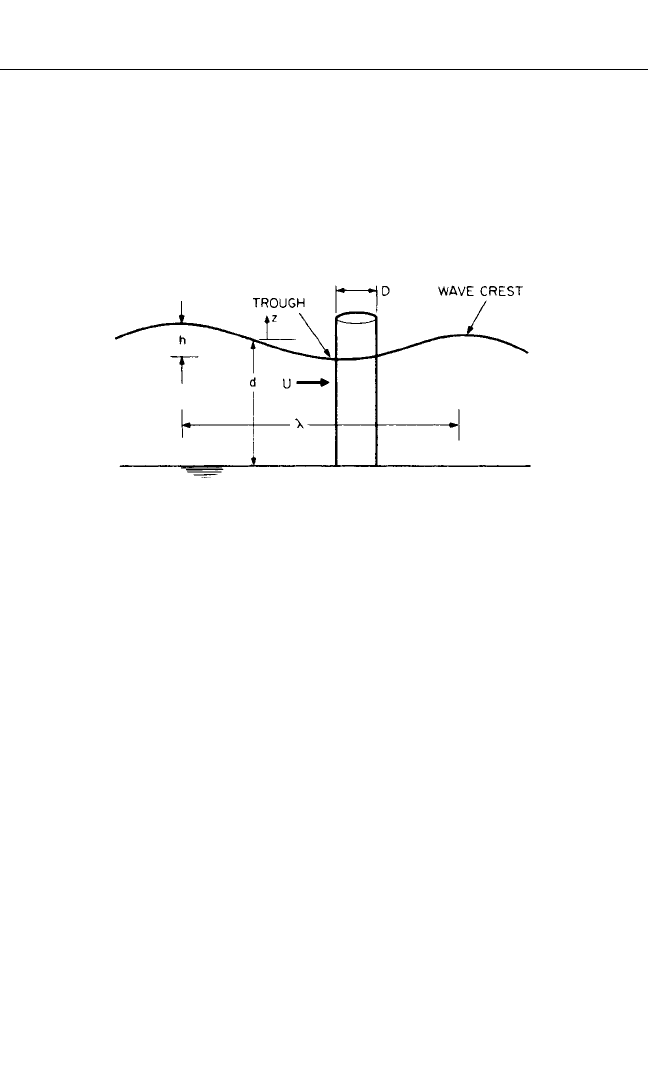
WAVE-INDUCED VIBRATION OF STRUCTURES
Waves induce vibration of structures, such as marine pipelines, oil terminals, tanks,
and ships, by placing oscillatory pressure on the surface of the structure.These forces
are often well-represented by the inviscid flow solution for many large structures
such as ships and oil storage tanks. For most smaller structures, viscous effects influ-
ence the fluid force and the fluid forces are determined experimentally.
Consider an ocean wave approaching the vertical cylindrical structure as shown
in Fig. 29.6. The wave is propagating in the X direction. Using small-amplitude (lin-
29.6 CHAPTER TWENTY-NINE, PART I
FIGURE 29.6 A circular cylindrical structure exposed to
ocean waves.
ear) inviscid wave theory, the wave is characterized by the wave height h (vertical
distance between trough and crest), its angular frequency ω, and the associated
wavelength λ (horizontal distance between crests), and d is the depth of the water.
The wave potential Φ satisfies Laplace’s equation [Eq. (29.2)] and a free-surface
boundary condition.
11
The associated horizontal component of wave velocity varies
with depth −z from the free surface and oscillates at frequency ω:
U(t, z) = cos
−ωt
(29.7)
This component of wave velocity induces substantial fluid forces on structures, such
as pilings and pipelines, which are oriented perpendicular to the direction of wave
propagation.
The forces which the wave exerts on the cylinder in the direction of wave propa-
gation (i.e., in line with U) can be considered the sum of three components: (1) a
buoyancy force associated with the pressure gradient in the laterally accelerating
fluid [Eq. (29.7)], (2) an added mass force associated with fluid entrained during rel-
ative acceleration between the fluid and the cylinder [Eq. (29.4)], and (3) a force due
to fluid dynamic drag associated with the relative velocity between the wave and the
cylinder. The first two force components can be determined from inviscid fluid
analysis as discussed previously.The drag component of force, however, is associated
with fluid viscosity.
Thus, the in-line fluid force per unit length of cylinder due to an unsteady flow is
expressed as the sum of the three fluid force components:
F =ρA
˙
U + C
I
ρA(
˙
U − ¨x) +
1
⁄
2
ρ | U − ˙x | (U − ˙x)DC
D
(29.8)
2πx
λ
cosh [2π(z + d)/λ]
sinh (2πd/λ)
hω
2
8434_Harris_29_b.qxd 09/20/2001 11:44 AM Page 29.6

where x = lateral position of structure in direction of wave propagation
A = cross-sectional area =
1
⁄4πD
2
of cylinder having diameter D
C
I
= added mass coefficient, which has theoretical value of 1.0 for circular
cylinder
C
D
= drag coefficient
This is the generalized form of the Morison equation, widely used to compute the
wave forces on slender cylindrical ocean structures such as pipelines and piers.
If ˙x and ¨x are set equal to zero in Eq. (29.8), the incline force per unit length on
a stationary cylinder in an oscillating flow is obtained:
F(˙x = ¨x = 0) = C
m
ρ
˙
AU +
1
⁄2ρ |U| UDC
D
(29.9)
Because of the absolute sign in the term |U| U, the force contains not only compo-
nents at the wave frequency but also components associated with the drag at har-
monics of the wave frequency. The resultant time-history of in-line force due to a
harmonically oscillating flow has an irregular form that repeats once every wave
period.
If the flow oscillates with zero mean flow, U = U
0
cos ωt as in Eq. (29.7), then the
maximum fluid force per unit length on a stationary cylinder is
ρAC
m
ωU
0
if <
F
max
=
ρU
0
2
DC
D
+ if >
(29.10)
If the cylinder is large (such as for a storage tank) with diameter D greater than the
ocean wave height h and if the wavelength of the ocean wave is comparable to the
diameter, then U
0
is small compared to ωD and the maximum force is given by the
first alternative in Eq. (29.10). The drag force is negligible compared to the inertial
forces for large cylinders.As a result, the ocean wave forces on large cylinders can be
calculated using inviscid, i.e., potential flow, methods which are discussed in Refs. 11
and 12.
For the Reynolds number ranges typical of most offshore structures, measure-
ments show that the inertial coefficient C
m
= 1 + C
I
for cylindrical structures gener-
ally falls in the range between 1.5 and 2.0. C
m
= 1.8 is a typical value. C
m
decreases for
very large diameter cylinders owing to the tendency of waves to diffract about large
cylinders (Refs. 13 and 14). Similarly, measurements show that the drag coefficient
falls between 0.6 and 1.0 for circular cylinders; C
D
= 0.8 is a typical value.
Wave forces on elastic ocean structures induce structural motion. Since the wave
force is nonlinear [Eq. (29.8)] and involves structural motion, no exact solution
exists. One approach is to integrate the equations of motion directly by applying Eq.
(29.8) at each spanwise point on a structure and then numerically integrate the time-
history of deflection using a predictor-corrector or recursive relationship to account
for the nonlinear term. A simpler approach is to assume that the structural defor-
mation does not influence the fluid force and apply Eq. (29.9) as a static load. This
static approximation is valid as long as the fundamental natural frequency of the
structure is well above the wave frequency and the first three or four harmonics of
the wave frequency. However, many marine structures are not sufficiently stiff to
satisfy this condition.
One generally valid simplification for dynamic analysis of relatively flexible struc-
tures is to consider that the wave velocity is much less than the structural velocity so
C
m
A
C
D
D
2
U
0
ωD
(ρAC
m
U
0
ω)
2
2πU
0
2
DC
D
1
2
C
m
A
C
D
D
2
U
0
ωD
VIBRATION OF STRUCTURES INDUCED BY FLUID FLOW 29.7
8434_Harris_29_b.qxd 09/20/2001 11:44 AM Page 29.7

that |U − ˙x| |U|.With this approximation, application of Eq. (29.8) to a single degree-
of-freedom model for a structure gives the following linear equation of motion:
(m +ρAC
I
)¨x + (2ζω
N
+
1
⁄2ρ |U| DC
D
)˙x + kx =ρAC
m
˙
U +
1
⁄2ρ |U| UDC
D
(29.11)
where m = structural mass per unit length
k = stiffness
ζ=structural damping
This equation is solved by expanding both x(t) and U(t) in a Fourier series and
matching the coefficients.
The fluid forces contribute added mass and fluid damping to the left-hand side as
well as forcing terms to the right-hand side. This equation may be simplified further
by retaining only the first (constant) term in the series expansion for |U| in the fluid
damping term so that the equation becomes a classical forced oscillator with con-
stant coefficient.
12
Flexible structures will resonate with the wave if the structural natural period
equals the wave period or a harmonic of the wave period. Since the wave frequen-
cies of importance are ordinarily less than 0.2 Hz (wave period generally greater
than one cycle per 5 sec), such a resonance occurs only for exceptionally flexible
structures such as deep-water oil production risers and offshore terminals. The
amplitude of structural response at resonance is a balance between the wave force
and the structural stiffness times the damping. Since the wave force diminishes with
increased structural motion [Eq. (29.8)], the resultant displacements are necessarily
self-limiting. In other words, the response which would be predicted by applying Eq.
(29.9) dynamically is overly pessimistic because the wave force contributes mass and
damping to the structure as well as excitation as can be seen in Eq. (29.11).
The above discussion considers only fluid forces which act in line with the direc-
tion of wave propagation. These in-line forces produce an in-line response. How-
ever, substantial transverse vibrations also occur for ocean flows around circular
cylinders.These vibrations are associated with periodic vortex shedding, which is dis-
cussed below. The models discussed in the following section for steady flow are
applicable to vortex shedding in oscillatory flows provided that the wave period
exceeds the period of shedding, based on the maximum oscillatory velocity so that it
is possible to fit one or more shedding cycles into the wave cycle.
13,14
VORTEX-INDUCED VIBRATION
Many structures of practical importance such as buildings, pipelines, and cables are
not streamlined but rather have abrupt contours that can cause a fluid flow over the
structure to separate from the aft contours of the structure. Such structures are
called bluff bodies. For a bluff body in uniform cross flow, the wake behind the body
is not regular but contains distinct vortices of the pattern shown in Fig. 29.7 at a
Reynolds number Re = UD/v greater than about 50, where D is the width perpendi-
cular to the flow and v is the kinematic viscosity. The vortices are shed alternately
from each side of the body in a regular manner and give rise to an alternating force
on the body. Experimental studies have shown that the frequency, in hertz, of the
alternating lift force is expressed as
16, 17
f
s
= (29.12)
SU
D
29.8 CHAPTER TWENTY-NINE, PART I
8434_Harris_29_b.qxd 09/20/2001 11:44 AM Page 29.8
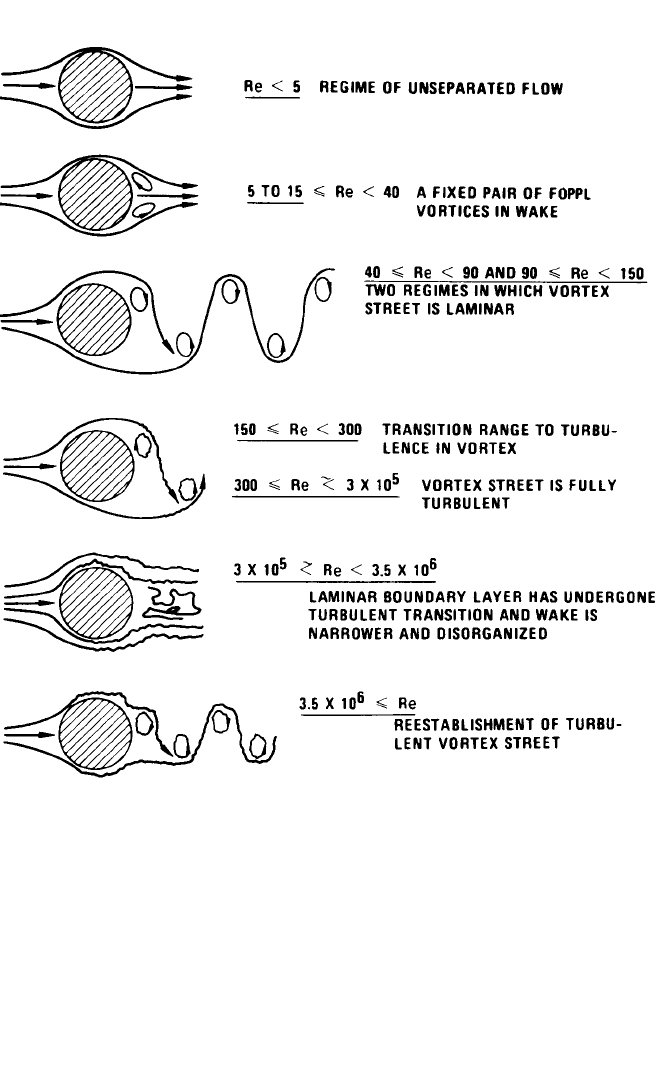
The dimensionless constant S called the Strouhal number generally falls in the range
0.25 ≥ S ≥ 0.14 for circular cylinders, square cylinders, and most bluff sections. The
value of S increases slightly as the Reynolds number increases; a value of S = 0.2 is
typical for circular cylinders.
The oscillating lift force imposed on a single circular cylinder of length L and
diameter D, in a uniform cross flow of velocity U, due to vortex shedding is given by
F =
1
⁄2ρU
2
C
L
DLJ sin (2πf
s
t) (29.13)
where the lift coefficient C
L
is a function of Reynolds number and cylinder motion.
The experimental measurements of C
L
show considerable scatter with typical values
ranging from 0.1 to 1.0. The scatter is in part due to the fact that the alternating vor-
VIBRATION OF STRUCTURES INDUCED BY FLUID FLOW 29.9
FIGURE 29.7 Regimes of fluid flow across circular cylinders.
15
8434_Harris_29_b.qxd 09/20/2001 11:44 AM Page 29.9

tex forces are not generally correlated on the entire cylinder length L. The spanwise
correlation length l
c
of vortex shedding over a stationary circular cylinder
17
is
approximately three to seven diameters for 10
3
< Re < 2 × 10
5
. In order to account
for the effect of the spanwise correlation on the net force on the cylinder of length
L, a factor J called the joint acceptance has been introduced on the right-hand side
of Eq. (29.13). Two limiting cases exist for the joint acceptance.
J =
1/2
if l
c
<< L
1 if fully correlated
Thus, if a cylinder is much longer than three to seven diameters, the lack of spanwise
correlation reduces the net vortex lift force [Eq. (29.13)] on the cylinder.
Cylinder vibration at or near the vortex shedding frequency organizes the wake
and changes the fluid force on the cylinder. Vibration of a cylinder in a fluid flow
can:
12, 17, 18
1. Increase the strength of the shed vortices.
2. Increase the spanwise correlation of the vortex shedding.
3. Cause the vortex shedding frequency shift from the natural shedding frequency
[Eq. (29.12)] to the frequency of cylinder oscillation. This is called synchroniza-
tion or lock-in.
4. Increase the mean drag on the cylinder. Mean drag can triple for one diameter
amplitude cylinder vibration.
5. Alter the phase sequence and pattern of vortices in the wake. Figure 29.8 shows
the patterns of vortices in the wake of a transversely vibrating cylinder, where
f
s
= natural shedding frequency [Eq. (29.12)], f = forced vibration frequency, and
A
y
= vibration amplitude transverse to flow.
As the flow velocity is increased or decreased so that the shedding frequency f
s
approaches the natural frequency f
n
of an elasticly mounted cylinder so that
f
n
≈ f
s
= so ≈=≈5
the vortex shedding frequency suddenly locks onto the structure natural frequency.
The resultant vibrations occur at or nearly at the natural frequency of the structure
and vortices in the near wake input energy to the cylinder. Large amplitude vortex-
induced structural vibration can result.
The vortex-induced vibrations of a spring-mounted cylinder in a flow are shown
as a function of velocity in Fig. 29.9 for two levels of damping. The horizontal scale
gives flow velocity nondimensionalized (i.e., divided by the cylinder diameter D
times the cylinder natural frequency f ), both of which are held fixed as velocity U
increases. The lower part of the figure shows the measured response cylinder single
amplitude A
y
vibration response as a function of flow velocity. The maximum cylin-
der amplitude occurs at the resonance condition U / ( fD) 5.5. The upper part of
the figure shows the vortex shedding frequency. The shedding frequency increases
with velocity as predicted by Eq. (29.8) until it equals the cylinder natural frequency
at U/fD = 5 and large amplitude cylinder vibrations begin. The shedding frequency
1
S
U
f
s
D
U
f
n
D
SU
D
l
c
L
29.10 CHAPTER TWENTY-NINE, PART I
8434_Harris_29_b.qxd 09/20/2001 11:44 AM Page 29.10

is entrained by the cylinder natural frequency. Entrainment persists until velocity is
increased to U/fD = 6.5 at which point lock-in is broken and the shedding frequency
abruptly returns to its natural value. In general, the larger the structural response to
vortex shedding, the larger the range of lock-in.
Both the amplitude of the structural response and the velocity range over which
lock-in persists are functions of the dimensionless reduced damping parameter δ
r
:
δ
r
=
where m = mass per unit length of cylinder, including added mass
ζ=damping factor for vibration in mode of interest, ordinarily measured
in still fluid
ρ=fluid density
D = cylinder diameter
The lower δ
r
, the greater the amplitude of the structural response and the greater
the range of flow velocities over which lock-in occurs (see Ref. 19 and Fig. 29.8). For
lightly damped structures in dense fluids (such as marine pipelines), δ
r
is on the
order of 1 and lock-in can persist over a 40 percent variation in velocity above and
below that which produces resonance.
Within the synchronization band, substantial resonance vibration often occurs.
Peak-to-peak vibration amplitudes of up to three diameters have been observed in
water flows over cables and tubing. The vibrations are predominantly transverse to
2m(2πζ)
ρD
2
VIBRATION OF STRUCTURES INDUCED BY FLUID FLOW 29.11
FIGURE 29.8 Patterns of vortices shed in the wake of a transversely oscillating cylin-
der in a cross flow.
8434_Harris_29_b.qxd 09/20/2001 11:44 AM Page 29.11
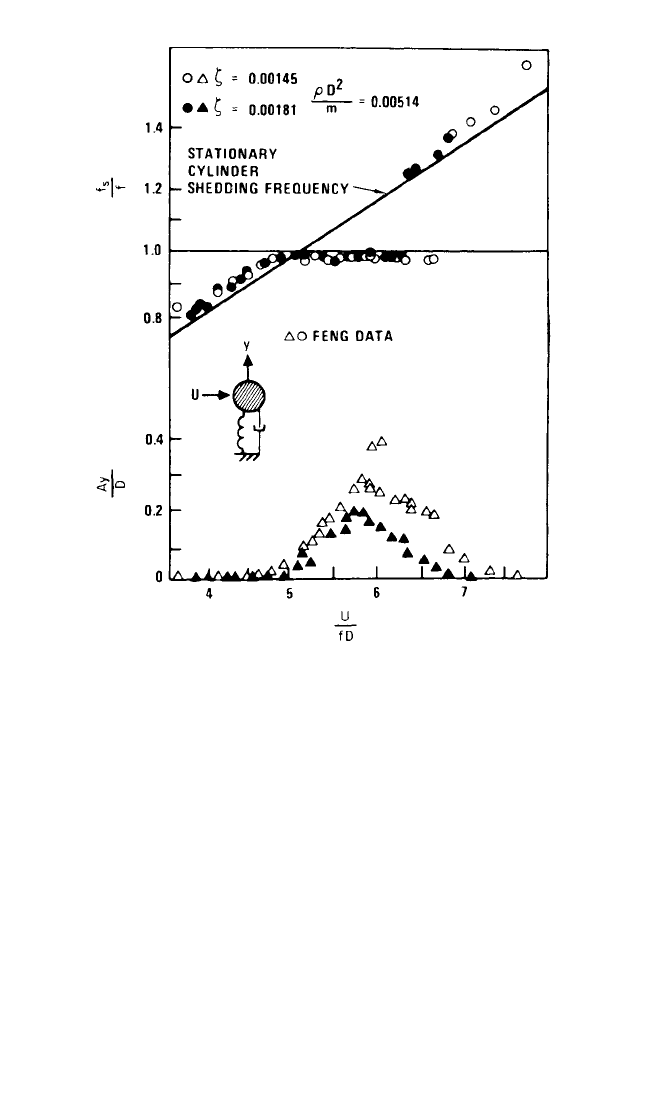
the flow and are self-limiting.
12
Lesser amplitude vibrations have also been observed
in the drag direction at twice the vortex shedding frequency and at subharmonic fre-
quencies of the vortex shedding frequency, i.e., at one-fourth, one-third, or one-half
of the flow velocity required for synchronization,
21
f
s
= f
n
.
If a uniform elastic cylinder is subjected to a crossflow uniformly over its span,
then the oscillating vortex-induced lift force is given by Eq. (29.13). At lock-in, the
vortex shedding frequency equals the natural frequency of the nth vibration mode
f
s
= f
n
, and the amplitude of the cylinder response is
= (29.14)
where the maximum amplitude vibrations along the span are y(t) = A
y
sin (2πf
n
t).
This equation is conservative if C
L
= J = 1. However, Eq. (29.14) gives overly conser-
vative predictions with C
L
= J = 1 owing to the tendency of the actual lift coefficient
to decrease at amplitudes in excess of 0.5 diameters and the lack of perfect spanwise
correlation at lower amplitudes. Semiempirical correlations are given in Refs. 12, 22,
and 23. One of these correlations is
12
C
L
J
4πS
2
δ
r
A
y
D
29.12 CHAPTER TWENTY-NINE, PART I
FIGURE 29.9 Response of a spring-supported cylinder to vortex-
induced vibration.
20
8434_Harris_29_b.qxd 09/20/2001 11:44 AM Page 29.12
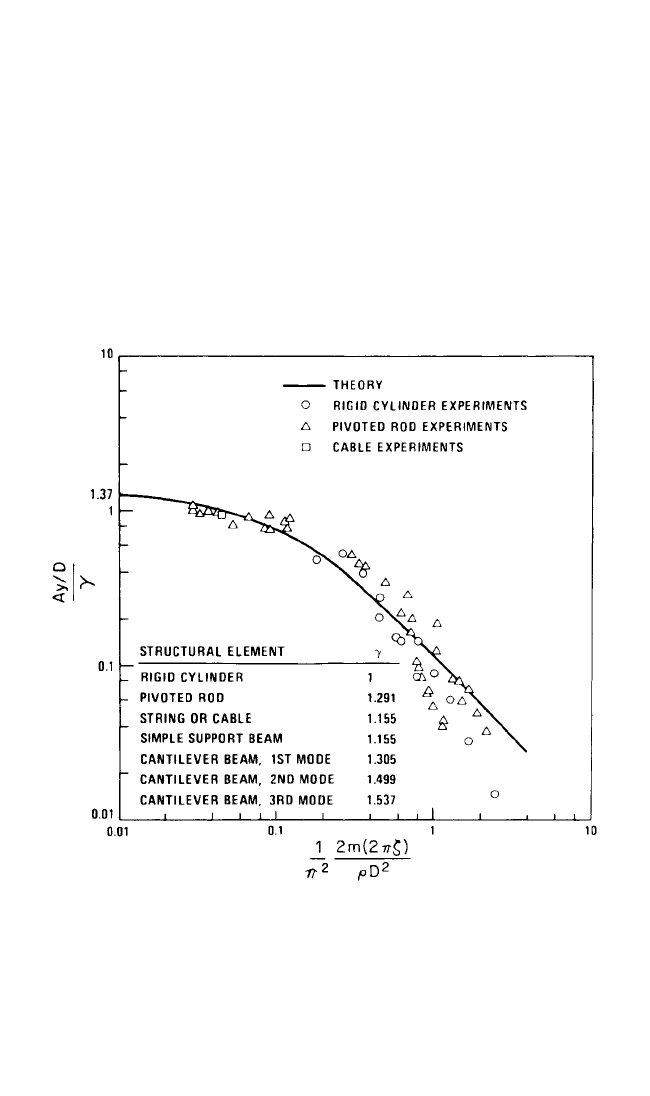
=
0.3 +
1/2
(29.15)
The mode shape parameter γ falls between 1.0 and 1.4. For a translating rigid rod
(φ=1), γ=1, for a cable or pipeline with a sinusoidal mode shape, γ=1.15 and for a
cantilever mode shape, γ=1.4 and A
y
is tip amplitude.
Equation (29.15) correctly predicts the self-limiting behavior of the resonance
vibrations. Setting damping to zero, δ
r
= 0, it follows that A
y
/D 1.5, which is a
typical vibration level for lightly damped marine cables in a current. See Fig.
29.10. Large amplitude vibrations also are associated with increased steady drag
on the structure. Drag coefficients of up to 3.5 have been measured on resonantly
vibrating marine cables as opposed to the typical value of 1.0 for a stationary
cylinder.
24
0.72
(δ
r
+ 1.9)S
0.07γ
(δ
r
+ 1.9)S
2
A
y
D
VIBRATION OF STRUCTURES INDUCED BY FLUID FLOW 29.13
FIGURE 29.10 Maximum amplitude of vortex-induced vibration as a function of
damping.
12
A number of fairings, strakes, and ribbons have been attached to the exterior of
circular cylindrical structures to reduce vortex-induced vibrations as shown in Fig.
29.11. These devices act by disrupting the near wake and disturbing the correlation
between the vortex shedding and vibration. They do, however, increase the steady
drag from that which is measured on a stationary structure. Reviews of vortex sup-
pression devices are given in Refs. 25 and 26.
8434_Harris_29_b.qxd 09/20/2001 11:44 AM Page 29.13
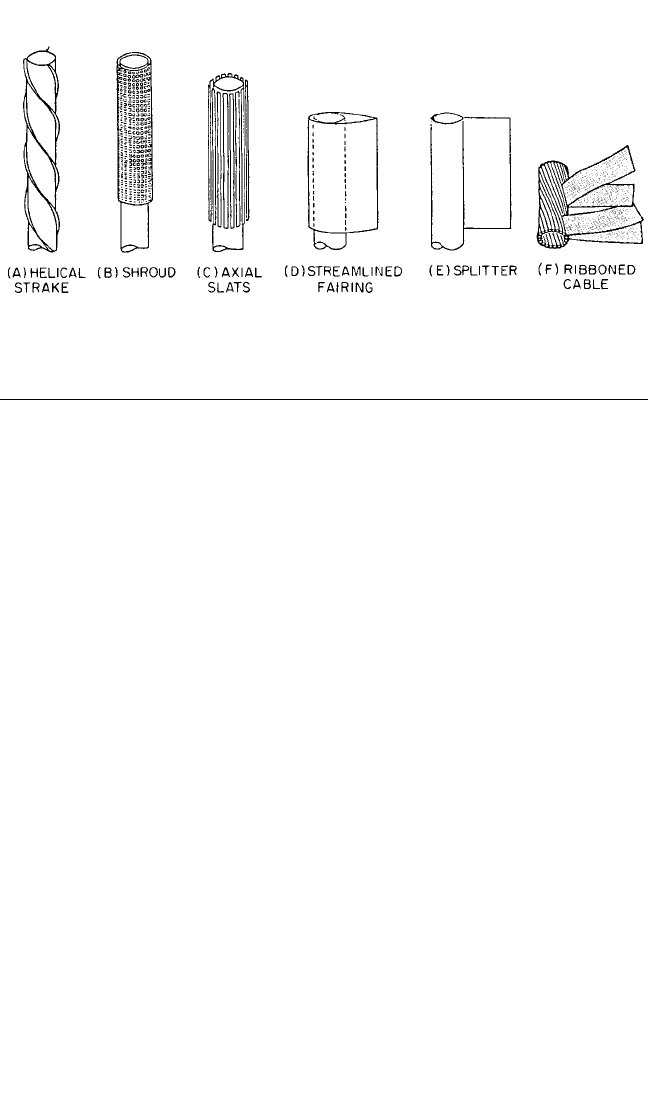
FLUID ELASTIC INSTABILITY
Fluid flow across an array of elastic tubes can induce a dynamic instability, resulting
in very large amplitude tube vibrations once the critical cross-flow velocity is
exceeded. This is a relatively common occurrence in tube and shell heat exchangers.
Once the critical cross-flow velocity is exceeded, vibration amplitude increases very
rapidly with cross-flow velocity V, usually as V
n
where n = 4 or more, compared with
an exponent in the range 1.5 < n < 2.5 below the instability threshold. This can be
seen in Fig. 29.12, which shows the response of an array of metallic tubes to water
flow. The initial hump is attributed to vortex shedding. The cross-flow velocity is
defined as velocity perpendicular to the tube axis at the minimum gap between
tubes. Once the critical velocity is exceeded, the very large amplitude vibrations usu-
ally lead to failures of the heat exchanger tubes.
Often the large amplitude vibrations vary in time; the amplitudes grow and fall
about a mean value in pseudorandom fashion. Generally the tubes do not move
independently but instead move in somewhat synchronized orbits with neighboring
tubes. This orbital behavior has been observed in tests in both air and water with
orbits ranging from near circles to nearly straight lines. See Fig. 29.13.
As the tubes whirl in orbital motion, they extract energy from the fluid (Refs. 12,
28, and 29). Below the onset of instability, energy which is extracted is less than the
energy which is expended in damping. Above the critical velocity, the energy
extracted from the flow by the tube motion exceeds the energy expended in damp-
ing, so the vibrations increase in amplitude. Restricting the motion or introducing
frequency differences between one or more tubes often increases the critical veloc-
ity for onset of instability. Such increases in critical velocity are generally no greater
than about 40 percent unless additional support is given to all tubes exposed to high
velocity flow. Often the onset of instability is more gradual in a bank of tubes having
tube-to-tube frequency differences than in a bank with identical tubes. Only a rela-
tively small percentage of the tube will become unstable at one time. Flexible long-
span tubes in areas of high flow velocity (such as at inlets) are most susceptible to
the instability.
At cross-flow velocities beyond those which produce an onset of instability, dam-
aging vibrations are encountered. The tube vibration amplitudes are limited by
clashing with other tubes, by impacting with the tube supports, and by yielding of the
tubes. Sustained operation in the unstable vibration regime ordinarily results in tube
29.14 CHAPTER TWENTY-NINE, PART I
FIGURE 29.11 Methods of reducing vortex-induced vibration.
8434_Harris_29_b.qxd 09/20/2001 11:44 AM Page 29.14
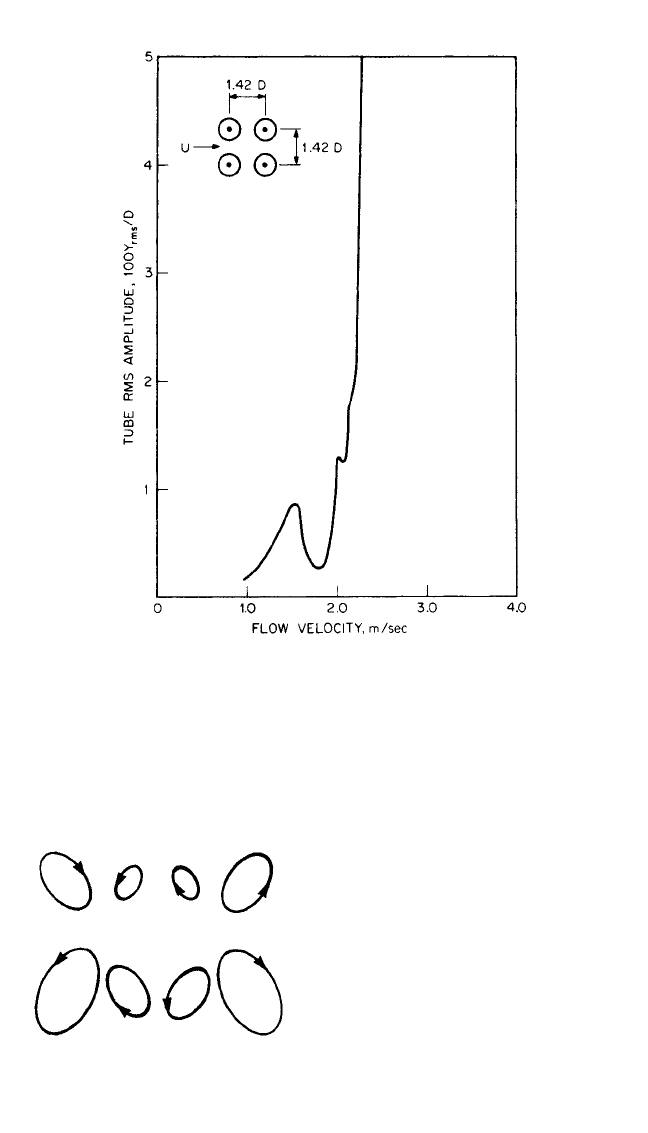
failure due to wear or propagation of cracks in the tubes. Fluid elastic instability is
second only to corrosion as a cause of heat exchanger failure.
A displacement model for the fluid elastic forces is given in Ref. 12 which correctly
predicts the observed onset of instability for most cases in air and gases. Results are
less satisfactory in water or when the
motion of some of the tubes is restricted.
More complex models take into account
velocity-induced forces as well as the
displacement-induced forces.
29,30
These
theories give somewhat better agree-
ment with data over limited ranges, but
none are entirely suitable for a design
tool.
The most viable, practical procedure
for predicting the onset of instability of
closely spaced arrays of tubes to cross
flow is to use the theoretical form given
by the displacement mechanism but
VIBRATION OF STRUCTURES INDUCED BY FLUID FLOW 29.15
FIGURE 29.12 Typical amplitude of vibration of a tube array
in cross flow.
27
FIGURE 29.13 Tube vibration patterns for
fluid elastic instability.
28
8434_Harris_29_b.qxd 09/20/2001 11:44 AM Page 29.15
